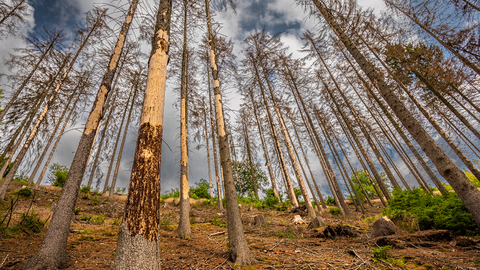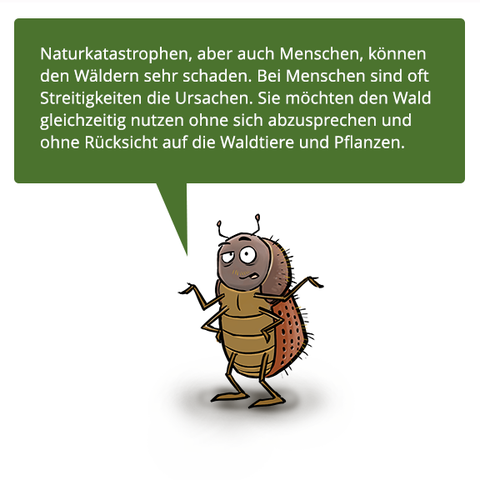Was kann Wald nicht leisten?
Wälder und ihr Umland stehen unter erheblichen menschlichen Einflüssen. Das verändert gewollt und ungewollt die Zusammensetzung ihrer Waldgemeinschaften und gefährdet ihr Zusammenspiel, die Waldleistungen und die Selbstregulation des Waldes. Waldverantwortliche steuern mit Pflanzenschutzmaßnahmen dagegen, z. B. über Aufforstungen, Zäune gegen Verbiss durch Rotwild oder Baumentnahmen und Insektengift gegen Borkenkäfer. Anhaltende Eingriffe oder erhebliche Störungen verändern dauerhaft die Verbreitungsgebiete und Zusammensetzung der Arten in den betroffenen Ökosystemen. Arten wandern ab oder sterben aus, neue Arten wandern zu oder entstehen. In diesen Phasen sind Ökosysteme sehr instabil. Bis sich in der belebten Welt ein neues Gleichgewicht eingestellt hat, ist auch die unbelebte Welt eine andere geworden. Böden, Gewässer und Atmosphäre verändern sich wie ihre Bewohner. Die Abläufe sind im Ansatz erforscht und verstanden. Bekannt ist, dass diese tiefgreifenden Umwälzungen infolge erheblicher Störungen in der Weltgeschichte immer wieder auftreten. Hierzu zählen die Phasen der großen Artensterben und der Klimawandel. Die Anpassungen der Wald-Ökosysteme dauerten Jahrtausende.
Seit rund 300 Jahren bringen die Menschen immer größere Mengen zusätzlicher Stoffe in die Lebenskreisläufe der Wälder und der Natur. Hierzu zählen künstliche Materialschöpfungen wie das Plastik oder die Abgase aus der Verbrennung von fossilen Stoffen wie Erdgas, Erdöl und Steinkohle. Viele dieser zusätzlichen Stoffeinträge können in den Lebenskreisläufen der Natur nur über Jahrhunderte bis Jahrmillionen abgebaut oder neu gebildet werden, daher werden beispielsweise fossile Stoffe als nicht nachwachsend bezeichnet. In den kurzfristigeren, natürlichen Stoffkreisläufen werden bereits die herkömmlichen Stoffeinträgen verarbeitet. Beispielweise werden freiwerdende Stoffe aus Verwesung und Atmung in Pflanzenwachstum und Früchten gebunden. Übermengen können nur begrenzt eingebunden werden. Folglich reichern sich zusätzliche Stoffeinträge und ihre Abbauprodukte zunächst an und lösen multiple Kettenreaktionen in der belebten und unbelebten Natur aus. Dazu zählen der aktuell laufende Klimawandel und das aktuelle große Artensterben. Diese Umwälzungen sind menschengemacht.
Nächste Frage: "Wie bleibt Wald erhalten?"
Zurück zur Übersicht von "Zuhause im Wald"


